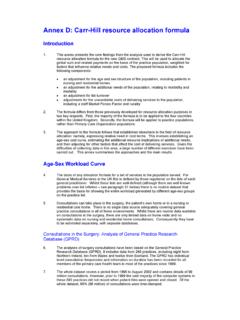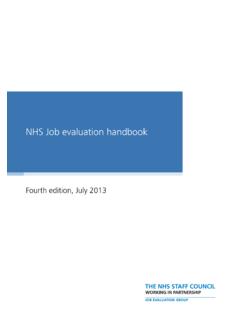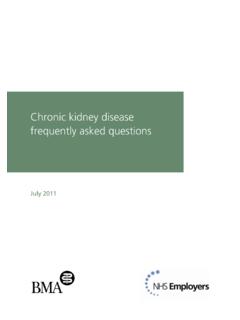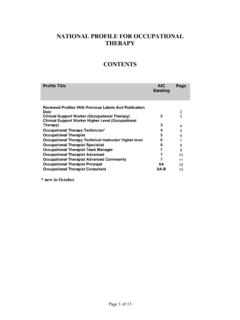Transcription of New initiatives to support staff retention - …
1 April 2018 New initiatives to support staff retention Guy s and St Thomas NHS Foundation Trust Organisation Guy s and St Thomas (GSTT) is one of the UK s busiest NHS foundation trusts. Comprising of St Thomas Hospital, Guy s Hospital and Evelina London Children s Hospital, it delivers adult and children s acute, tertiary and community services in Lambeth and Southwark. The trust employs approximately 15,900 staff and sees over two million patient contacts a year. It is one of the largest employers locally and works hard to reflect the cultural and ethnic diversity of the communities it serves. What was the aim/problem? GSTT faces unique challenges in recruiting and retaining staff . It has seen a 30 per cent growth in staff over five years and, for an inner London trust, the voluntary turnover rate (voluntary early retirement and voluntary resignation) fares quite well at per cent.
2 However, when the trust analysed its data in 2016, it discovered some unexpected statistics including: 40 per cent of leavers could have been prevented 18 per cent of nurses were leaving the trust within their first year a 50 per cent post-offer drop out (40 per cent in nursing). The reasons given by the 40 per cent of leavers included career progression, specialty change, work-life balance, and relationships with line managers. retention hotspots were found in community settings, theatres, critical care and acute medicine. The trust initially believed there was limited scope to improve retention due to the high cost of living in London, the rich NHS employment market, staff preference to work close to home, and a transient workforce. However, feedback from exit questionnaires and staff focus groups indicated that the organisation could increase staff retention by focusing on some key areas.
3 What was the solution? In 2017, GSTT set up a corporate retention group comprising HR business partners and stakeholders from clinical staff groups, to develop a strategy to retain staff with key skills and experience. The group focused on the following key areas. 1. Career navigation and coaching A career progression toolkit was developed to help staff identify development opportunities and to support them through the recruitment process. Career coaching sessions were offered to all newly qualified nurses and midwives. The sessions gave staff the opportunity to evaluate their progress to-date and start to explore future career aspirations. Five coaches from nursing and midwifery backgrounds were provided with information on relevant courses and career pathways to ensure they were aware of opportunities available to staff .
4 staff were encouraged to bring their preceptorship pack and book onto sessions. 2. Stay discussions Stay discussions were piloted in hotspot areas with high staff turnover rates. Managers were encouraged to support staff during stay discussions and feedback any key themes centrally. The data was used to further inform initiatives to aid retention . Following a successful pilot, stay discussions have now been rolled out across the organisation. 3. Flexible working The trust is working in partnership with Timewise, a recruitment consultancy that helps businesses to attract and develop talent through flexible working. The aim is to enhance the profile of flexible working at GSTT and support managers and staff to develop arrangements that benefit both the organisation and the individual. These arrangements are expected to evolve as service provision develops.
5 St Thomas maternity service has adapted rosters to include one short night shift (10pm to 6am) providing greater flexibility for staff with caring responsibilities. This has helped the directorate to maintain low vacancy rates and high staff retention amongst midwifery staff . 4. Transfer process The trust simplified the process for nursing staff wishing to transfer to a different speciality/service on the same band. The trust has found that by promoting windows of opportunity, it enables staff to express an interest in vacancies before posts are filled by external candidates and in advance of the annual intake of newly qualified nurses. The trust is developing a similar process to offer all internal staff opportunities for sideways moves for those that wish to try a new challenge. 5. Early engagement post-offer To reduce the post-offer dropout rate, managers were encouraged to keep in touch with appointees and to start the engagement relationship earlier.
6 Appointees are now invited to attend team meetings and team events. This has helped to establish a relationship with the trust and early team cohesion. 6. Leavers discussions and keeping in touch Managers actively encourage leavers to participate in discussions to understand what could have prevented them from leaving. The trust is building a database of leavers to keep in touch with about news and vacancies to encourage staff who may wish to return in the future. 7. Accommodation Due to the rising cost of housing, the trust offers a rental deposit loan to nursing and allied health professional (AHP) staff of 1,500 which has been welcomed by new staff . There are plans to launch a rent-a-room scheme to newly qualified nurses where existing staff offer rooms to junior colleagues. Longer term accommodation strategies are being developed with local housing schemes, co-operatives and developers to identify partnership arrangements.
7 What were the challenges? The main challenge with implementing new processes has been getting managers to see them as business as usual and not a one-off initiative or an extra administrative burden. One example of how this has been overcome is the stay discussions which are now a 15 to 20-minute conversation over coffee rather than an hour out of the day with lots of paperwork to complete. Another challenge has been around flexible working and how requests can be supported by managers. The trust is working on some trickier team-based flexible working approaches, for example, flexible self-rostering and testing annualised hours working and other less used flexible working practices to build some case studies to promote to the wider organisation. What were the results? Efforts to improve retention are still in an early phase, however, initial turnover metrics reveal some positive movement: staff turnover has reduced from per cent in 2016/17 to per cent in 2017/18 preventable leavers have reduced from 40 per cent in 2016/17 to 34 per cent in 2017/18 post-offer drop out has reduced from 50 per cent in 2016/17 to 27 per cent in 2017/18.
8 What were the learning points? The trust identified some key learning points which may be useful to other organisations. Analyse the existing data held by your organisation and focus on hotspot areas. Engage with HR business partners from the outset. Get buy-in from clinical stakeholders. Simplify stay discussions listen to staff feedback. Review internal transfer process and simplify. View new initiatives as part of a continuous improvement journey. Next steps and sustainability GSTT is working in collaboration with its sustainability and transformation partnership (STP) to tackle retention issues across the region. Specifically, the trust is focusing on interventions to reduce the high number of nursing and administrative staff leavers in the first year. The intention is to roll out stay discussions to the wider organisation as well as focusing on student nurse, AHP and doctor retention .
9 The trust is developing an online system to provide staff with the ability to tailor their employment journey. The system also allows the trust to engage with staff on social media, and keep in touch with leavers who may potentially return in the future. Want to know more? Lynn Demeda, Deputy Director of Workforce, Trust resources Guy s and St Thomas NHS Foundation Trust documents. Career progression toolkit. Nursing staff transfer process. Stay discussion guidance. Leavers discussion guidance.

















![[Escriba texto] - anmat.gov.ar](/cache/preview/7/7/0/4/3/2/b/a/thumb-770432baa488d2b2df2ed6eb34dcafce.jpg)
